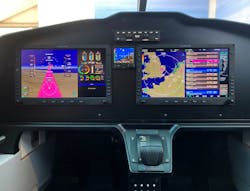VoltAero selects Avidyne to provide custom avionics suite for its Cassio 330 hybrid-electric aircraft
MEDIS, France - VoltAero in Medis, France, the creator of its Cassio 330 hybrid-electric aircraft, needed a custom avionics suite. They found their solution from Avidyne in Melbourne, Fla.
The Cassio 330 will be equipped with a glass cockpit incorporating Avidyne’s new-generation Quantum 14-inch displays in a dual primary flight display/multi-function display (PFD/MFD) configuration. In addition to the screens’ size, the Quantum displays provide brightness and synthetic vision system (SVS) capabilities at 4K resolution.
Avidyne will customize the avionics’ human-machine interface (HMI) specifically for the Cassio 330’s flight operations, significantly facilitating the pilot workload while managing the aircraft’s electric-hybrid propulsion system. The avionics suite will simplify the pilot’s decision-making process, as well as improve flight safety and simplify pilot training. Additionally, the avionics are designed for the connected aircraft environment.
The Cassio 330 is the first of three Cassio aircraft versions to be developed by VoltAero for seating capacities of up to 12 persons. VoltAero unveiled its no. 1 Cassio 330 prototype at last week’s Paris Air Show. Also at the Paris Air Show, Avydine’s Quantum avionics suite was shown for the first time, incorporated in VoltAero’s full-scale Cassio 330 cabin mockup on its exhibit stand.
Designed with a five-seat cabin, the Cassio 330 will be powered by a 330-kilowatt electric-hybrid propulsion system. The follow-on six-seat Cassio 480 will have an electric-hybrid propulsion power of 480 kilowatts, while the Cassio 600 is sized at a 12-seat capacity with electric-hybrid propulsion power of 600 kilowatts. All three versions share a high degree of commonality as a result of VoltAero’s modular design strategy.
Cassio aircraft will utilize electric motors in the aft fuselage-mounted hybrid propulsion unit for all-electric power during taxi, takeoff, primary flight - if the distance traveled is less than 150 km. - and landing. The hybrid feature (with an internal combustion engine) comes into play as a range extender, recharging the batteries while in flight. Additionally, this hybrid element serves as a backup in the event of a problem with the electric propulsion, ensuring true fail-safe functionality.
